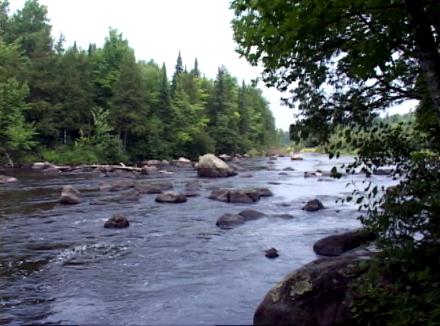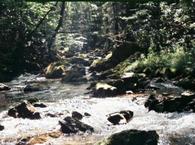
The Wolf River is a first class trout stream and can hold its own with any trout stream in the USA and it is Wisconsin’s largest trout stream. The Wolf River in Upper Northeast Wisconsin starts as tiny streams and becomes a stream at the outflow of Post Lake. The Wolf River is much like a Western trout stream in that it is fast enough to make it a popular river to raft. The Wolf is a slightly alkaline river averaging about 150 feet wide and is surrounded by northern hardwood trees, as well as spruce and fir trees that make it a beautiful river indeed. Although the wolf has about 60 miles of trout water before it reaches the southern boundary of the Menominee Indian Reservation, only the first 34 miles are accessible to all anglers. The remainder of the Wolf River is reserved for Indian anglers.
The 34 mile fishable section of the river begins below the confluence of the Hunting River, a tributary stream. Some of the stream's tributaries, including the Hunting River, hold populations of brook trout. Most of the trout in the main river are browns along with some rainbows. The deep pockets and large number of rocks and boulders in the stream provide an excellent habitat for brown trout. The large trout are mostly holdovers from previous years and can become quite difficult to catch. There are also some wild trout, especially in the lower section below Lilly.
The portion of the river from Pearson to Lilly, where SR 52 crosses, is mostly slow flowing water with a bottom of silt making it ideal for the Hexagenia atrocaudata (slate drake) hatch. Below Lilly, the gradient increases and the rapids start causing the water to swirl over submerged rocks. The general character of the water in this area consists of moving pocket water with riffles, pools and runs. The trout will seek the highly oxygenated water during hot weather and warm water temperatures. This is also the section of the river that has some natural reproduction of trout. It cannot sustain the population the state wants it to have and supplemental stocking is done. Some prefer to fish this section of the Wolf River from a rubber raft. It can be very dangerous to wade as the flows can reach as high as 2000 cfs and the deep holes are easy to step into if you are not careful. If you choose to wade this section, please use a wading staff and use extreme care.
Later in the summer, during periods of low water, the water settles down and the flows run as low as 50 cfs. which tends to make the Wolf much more wadable. The water temperature can reach into the low eighties during this time. For this reason the trout are regularly stocked during the summer and the trout will seek relief where small springs seep into the river.
Fly Fishing the Wolf River:
The hatches on the Wolf River can be very large. The insects can blanket the water at times. The pH of the river is very good and aquatic insects of a large variety grow well in the river. The upper section which consists of slow moving water with a soft bottom has a completely different variety of insects than the lower fast water sections of the river. Dry fly fishing can be good but otherwise you are better off fishing nymphs or streamers. Nymph fishing in the deep holes can be very effective if done correctly. The high stickin method of fishing nymphs works great in the faster sections of the river.
In the upper, slow moving water, it may be necessary to make downstream presentation but otherwise, fish in an upstream direction. From Pearson downstream to Lilly the river gradually declines. The flow is generally slow compared to some sections and there are only a couple of areas of fast water. From Lilly downstream to the Indian Reservation, the river drops at a much greater decline.
The ideal fly line size would probably be a 5 weight, floating fly line. Many anglers would want to use a 4 weight fly line if they were strictly fishing for brook trout in the tributary streams. However, a 6 weight fly line on a six weight rod would deliver most of the streamers and heavy nymphs better than the 5 weight line. The rod should be a four or five weight about 8 to 9 feet in length and with a medium to medium fast action. For the reel be sure that it has a good drag.
The leaders should from 2X for streamers going up to 7X for the midges and they should be greater than 7 feet. A nine foot would be ideal for most cases but you might want a shorter leader for streamers. Keep a range of tippets from 3X to 6X. For flies, we recommend the Perfedt Fly series of flies and why do we recommend these flies?
Spring:
Springtime can be tough fishing until the water levels recede. You may have to fish from a rubber raft. Blue-winged Olives hatch in March and April and since they are bi-brooded, they hatch again during the month of September. Hendricksons hatch during the month of April and on into the first week or two of May, depending on the water and weather.
Beginning about the first of May you should find some Sulphurs that hatch through the month and on into the first couple of weeks in June. Around the last week of May and the first couple of weeks of June you will find Eastern Pale Evening Duns. These are very much like the Sulphurs, just a little larger. There is a Little Black Caddis hatch that occurs in late April and early May.
Summer:
Early summer is usually the prime time to fish the Wolf River. The Brown Drakes provide a very good hatch normally in the first three weeks of June. The large Michigan Caddis or Hexagenia Limbata hatches about the middle of June through the first week or so of July. Also, for most of July there is a large Trico hatch underway. Slate Drakes will hatch from the last week of June all the way into the middle of August. Little Yellow Quills will start to hatch in late July and continue through month of August. The month of August will also see the White Flies hatch. The Trico, Brown Drakes, Michigan Caddis and White Flies are found mostly in the upper slower water with a soft bottom.
Fall:
Fall can be great and the time the browns spawn. There are several species of Spotted Sedges and Cinnamon Sedges that hatch in late June all the way until the end of August. Midges hatch during most of the year, especially in the slower water in the upper sections of the river. Imitations of their larvae, pupae and adults will catch trout all year but are most effective when few other insects are hatching early and late in the season. The Wolf River is full of crayfish and streamers that imitate them can be very effective on the large brown trout. There is also a population of sculpin as well as some minnows and other small baitfish. Streamers will work well for brown trout early or late in the day and anytime the water is high or slightly dingy as well.
Winter:
It is possible to catch trout on the better days.
State owned access is available along highway #55 and at several bridges including the bridges at SR 64 at Langlade, and SR 52 at Lilly. The Military Park access about 6 miles north of Lilly is an excellent location. There are many other access points including Wood River Road off of SR 55 about 3 miles south of Lilly. There's a special six mile long catch and release section that starts at the railroad trestle at Hollister and extends downstream to Dierck's Irrigation Hole.
Hatches are discussed in the artice above.





